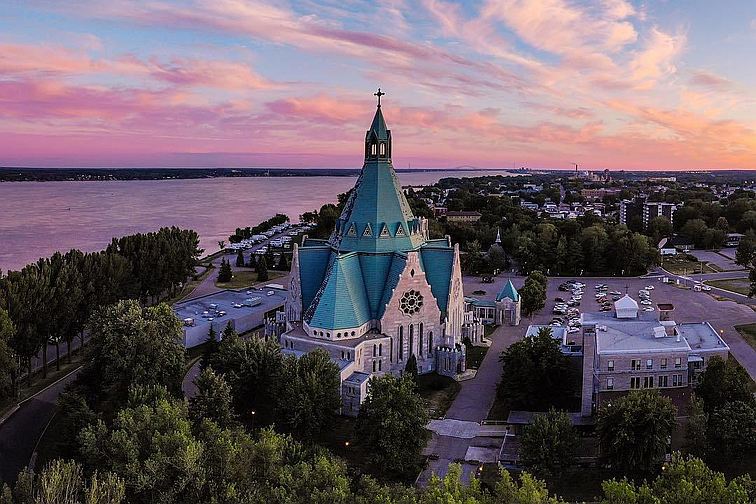
Welcome to Notre Dameby Fr. T. Murphy

The history of Cap-de-la-Madeleine can be said to have begun with the colonization of Canada, and to have entwined itself in the ups and downs of this colony. On October 7th, 1535, Jacques Cartier had planted the Cross on an island at this place and had claimed the country in the name of Christ. Here he had found what seemed to be three rivers flowing into the mighty St. Lawrence and so he had called the place "Three Rivers" (Trois-Rivières). Then in 1634, Laviolette came to this spot and founded there a trading post and mission center. It was to this post that the Indians brought their goods to sell to the traders. Here came the friendly Algonquins from the north; from the west the Hurons, the friends of the Franciscans; from the southwest, now known as the middle of New York State, came the Iroquois. It was from this post that Saints Isaac Jogues and René Goupil left to further the mission work, but were instead captured by the Mohawks and were eventually martyred at Auriesville, N.Y.
History tells us that there was always a certain amount of dispute about who owned the land on which the mission/trading post stood, and Fr. Buteux, S.J., had been for years trying to have this matter settled. In 1651, there arrived in Canada a deed which gave this place and the land to the Jesuits. This deed came from the parish of Sainte Madeleine at Chateaudun, in France, and so this spot became known as Cap-de-la-Madeleine or the Cape of the Magdalen.
Now came the building of the first wooden church at the mission post, which was to serve as a link between the start of Cap-de-la-Madeleine and its present state. This was unintentional but factual, because it was written into the contract for the new stone church that the hand hewn beams in this old wooden church were to be used in its construction (image below). Later inspection of these beams proved that they were as stout and as strong as when they were hewn in 1659. The mission post grew and prospered, and from here the Faith was spread in all directions. This period is referred to as the Period of Growth in the history of the Shrine.
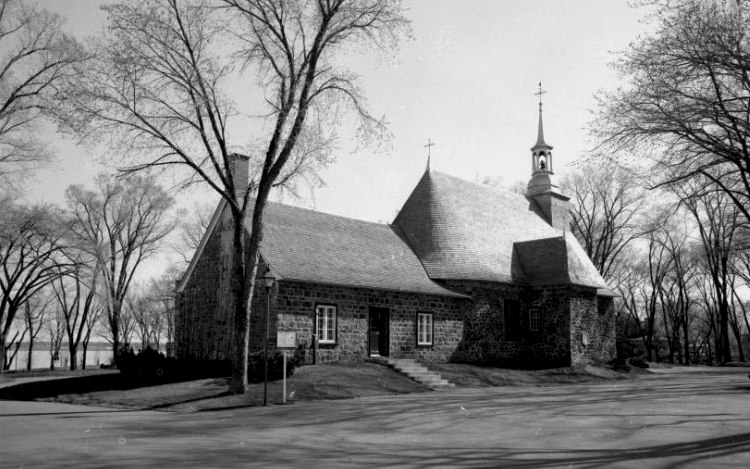
But now came the long night of darkness when it seemed as if the glory of the Cape would never shine forth again. The Thirty Years War began in Europe, and life in the colonies was patterned after that of the parent country, France, as is usual in times of war. France was so stricken at home that not much thought was given to her Colonies in the New World. Moral laxity, which follows wars, wrought havoc in Canada, and we read that Cap-de-la-Madeleine grew lax and declined with the rest of the country. In 1713, after the end of the Anglo-French Wars, the priest at the Cape was Fr. Paul Vachon, who was certainly a gem in Our Lady's crown. Despite the war and the neglect, this priest had worked very hard to keep the Cape a place of glory. He became almost a legend with his saintly zeal and his mark has been left on the Shrine even to this present day. Despite the war and the neglect, despite the apathy of the people, despite the apparent neglect of the mother country, Fr. Paul Vachon succeeded in forging two of the strongest links in the chain of events which unite the glorious beginnings with the present. The first of these links forged by Fr. Vachon was the establishing of the Confraternity of the Most Holy Rosary at Cap-de-la-Madeleine. This could be done only by permission of the Master General or Superior of the Dominican Order and has a very simple set of rules laid down, which have been followed all over the world in every country and in every language. Permission for the formation of this Confraternity was received in 1694, and the original document of Charter is still in existence today, zealously guarded by the Oblate Fathers in the Shrine's archives. The second link with Fr. Vachon and the present time is the little stone church that stands in the center of Mary's domain. This church was started in 1714 and finished six years later. But it was a church built on poverty and sacrifice. In fact, were it not for the support of almost all of Canada, as it was then, it would not have been possible for the church to have been built. This church became the focal point of the Shrine and Catholics from every part of Canada have knelt there and prayed to Our Blessed Mother.
Canon Vachon died in 1729 and with his death the twilight era and the night settled down on the Cape. He was the last priest to live in the parish until the middle of the 19th century, and for 115 years there was to be no Blessed Sacrament in the Tabernacle, no Sanctuary lamp lighting the church, and no resident priest to keep the bloodstream of Faith flowing among the people of the parish.
We must remember that this was the same period when rank materialism had taken over in almost all of Europe and God was becoming an outcast among the freethinkers and ideologists. This was the age that bred the warped and obscene revolutions in France and the Continent; that saw churches desecrated, the Religious Orders proscribed and death handed down to anyone and to all clergy and religious who dared defy the new era of disbelief. It would seem that the dark night of materialism had descended forever and that the persecuted Church must suffer for many years in its agony. Science, as formulated by the intellectuals of the revolutions, took the place of God and man boasted that he no longer needed God. The revolution failed but the irreligious spirit lived on and on, and even spread to the thoughts of the ordinary man. But now the night was ending and the dawn was breaking on a new era, an era that can be said to be the Era of Mary.
So, too, at Cap-de-la-Madeleine, the dawn of the new era broke and though liberalism was still rampant, the dormant parish started to awake from its slumber. The parish was reopened in 1844 but there was very little success in this effort and the ecclesiastical authorities were very discouraged with the results. The people seemed to be almost impregnable in their cloak of materialism and apathy. But about now the next link in the chain of events was formed, a link that joined the stone church and Confraternity of the Rosary to the later magnificence of Our Lady's Shrine. This link was the statue of Our Lady which was donated by a parishioner, M. Zepherin Dorval, who was about to leave for the gold fields to seek his fortune there. M. Dorval wanted to have Our Lady's protection during his journey and trials and so he donated this statue which portrays Our Lady as She appeared to Catherine Labouré in Paris in 1830 (image on home page). Here, too, we can see some remarkable coincidences. Our Lady had appeared to Catherine Labouré in 1830 and to the children at La Salette in 1846. The Dogma of the Immaculate Conception was promulgated in 1854 and Lourdes was the scene of Her visits in 1858. It is not too much to conjecture that as Our Holy Mother had already begun Her campaign in Europe to win back the world to Her side, now She was preparing to win back the New World in a similar manner; that there was a purposeful inspiration behind the donating of the statue that later was to become the focal point of the Shrine. The statue has remained in the Shrine ever since except for a very special occasion when a visit was made to nearby Three Rivers in 1954. St. Joseph's Altar is erected on the very spot where Our Lady had Her first statue and Altar in the church up to June 22, 1888.
There came now to the Parish of Cap-de-la-Madeleine, the priest whose influence was to be so great in the formation of this Marian home. Fr. Luc Desilets came to the Cape in 1864, and to a man of his caliber it must have seemed disappointing to say the least. He was a young man born in 1831, and had achieved some notable standing in the diocese. He was ordained at the age of 27 years and already the Bishop had marked him as a man of great spiritual and intellectual qualities. In fact, he made him his secretary immediately after his ordination. This was the man who now came as pastor to the parish of Cap-de-la-Madeleine. To the Bishop, it was apparent that the parish needed some priest well versed in theology and capable of answering the skeptics and the materialists, and capable also of giving solace and hope to those who still remained true to God. To Fr. Desilets this should have been a prosperous and religious parish. Were there not 200 families or about 1,000 parishioners? Surely this must be a place where work could be accomplished. But Fr. Desilets knew that all the priests who had been appointed during the previous twenty years had had little or no success. All he could do was trust the Blessed Mother and ask Her to guide him.
During the first few years Fr. Luc made little or no headway and he could barely count on ten people who would come to church, either to pray or to listen to his sermons. Maybe he tried to analyze the reason for this apathy, but failed to find an answer. Other places in Canada which had experienced the same political upheaval had been able to shake loose the chains of materialism and return to their Catholic Faith. But not so Cap-de-la-Madeleine. It was just stuck in the morass of lethargy and Fr. Desilets was painfully aware of this.
In 1867 as the Feast of the Ascension approached, Fr. Desilets decided to make one last gigantic push to arouse the parish and if this failed then he, too, would ask the Bishop to transfer him to another parish. No one was more eloquent, more pleading, than he, as he spoke about the great Feast that was at hand and how the people should make this effort to reunite themselves to God through the Sacrament of Penance. To each and all he said he would be available all day on Ascension eve for Confessions. Then came the eve itself, but not a single person from the whole parish came to Confession. Not one of them had listened to his plea. How disappointed the good priest must have been, how discouraged he must have felt that not one soul had heeded his call. But the worst was yet to come.
It was dusk and time to close the church for the night. Fr. Desilets made his way towards the church, where the
flickering sanctuary lamp beckoned him to kneel before the Altar and pour out his loneliness and grief to Our Lord in the Tabernacle.
He had reached the bottom. Or at least he thought so; but he was soon to find out that the bottom was deeper than he realized.
As he entered the church he heard a strange chomping noise, and he went to the front to locate the noise but was stopped short
by what he saw. In that second he had reached the nadir of loneliness and discouragement. Then he rushed forward up the little
church to the Gospel side and there he saw a big, dirty pig snorting and scrambling around the Altar, and in its mouth were Rosary beads,
on which it was chewing – a Rosary that somehow had been dropped in the church. Horrified, Fr. Desilets somehow managed to snatch
the beads from the pig and then chased it from the church saying to himself: The people have dropped the Rosary and the pigs have
picked it up.
He turned back into the church and going up to the Altar rails he knelt there and prayed, vowing that he would spend the rest of his life in the spreading of the Confraternity of the Rosary, not only in his own parish, but wherever his voice would be heard. Our Lady had started the foundations of Her Shrine, and Fr. Desilets was to be the builder. A parish of lukewarm Catholics was to be radically changed by the power of the Rosary.
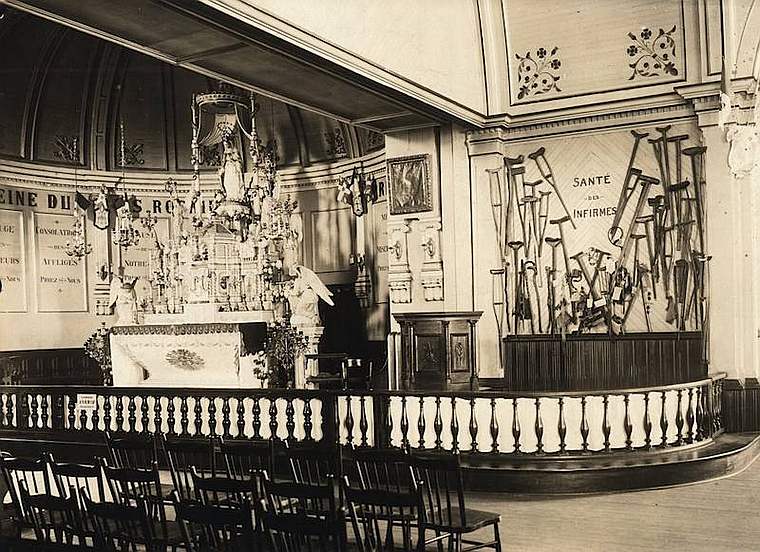
For the next five years, Father Desilets toiled in fulfillment of his vow and we read in 1872 in a letter to the
Master General of the Dominican Order the following words: I am happy to tell you that our Confraternity of the Rosary has spread
much during the last few years, and it is on the way to spreading still further in the Diocese of Three Rivers and elsewhere.
It now counts about 3,000 people.
What was even more pleasing still was the great number of spiritual favors that were being
received, and people were also speaking of great temporal favors attributed to the use of Blessed Roses. The blessing of roses was
an old tradition and Fr. Desilets carried it on by blessing roses at the Confraternity Altar. The people would then take them home
and apply either the petals, or rose water made from the crushed petals, to the sick. This practice still continues and cures are
still attributed to the use of the roses or rose water.
But the heavy burden of work took its toll and Fr. Desilets became ill. So he was given an assistant, Fr. Duguay, to help him take care of the increasing crowds who were now beginning to visit Cap-de-la-Madeleine. Fr. Duguay was appointed in August, 1878, and from now on he was to devote his entire being to the glory of Mary and Her Divine Son. It is through him that we have a record of most of the things which happened. This was because Fr. Desilets, out of humility, did not like to put things into writing, especially those things with which he was intimately connected. But Fr. Duguay had the enthusiasm of youth and the flair for writing about the ordinary happenings that fill in so much of the historical background.
It had been decided that this parish needed a new church because the crowds that were coming there now more than filled the little stone church. So plans were made and in the summer of 1878 the stone was dressed in the quarries at the far side of the St. Lawrence River. The men had hoped that the river would freeze over so that the stones could be transported across the river on sleds, even though at this point the river is over a mile wide, rapid and deep. Another difficulty was that, where the Shrine stands, there is nothing but sand and clay. This was demonstrated very clearly when the foundations for the new Rosary Basilica were being laid. The builders had to drive piles down 91 feet into the ground before they hit solid rock.
By the Fall, all was in readiness in the quarries. The stones were dressed and gathered together, ready for the sleds to cross over the ice. Fr. Desilets knew enough about the St. Lawrence River not to count on its being frozen. So in November, he ordered that public Rosaries should be said each Sunday after High Mass – asking Our Lady's intercession so that the river would freeze over. Fr. Duguay was now doing more and more work in the parish and each Sunday he would lead the public Rosary – all fifteen decades. December came and there was no ice on the river. January and February came and there was still no ice on the river. What was more, the people began to grumble, and who can blame them? The farmers knew that if the weather continued cold enough for ice that they would have a late Spring, with the results that the crops would be planted late – perhaps too late. The parishioners were grumbling because here they were Sunday after Sunday praying and praying, but to no apparent avail. Between each of the fifteen decades there would be a homily by Fr. Duguay on that mystery of the Rosary – and this after High Mass and a sermon. They were really going all out, but it seemed nothing was happening. This is God's way in nature – the darkest part of the day is just before the dawn, and how wonderful the dawn seems after the darkness of the night. So it is with us. Things seem darkest when our prayers are not immediately answered; but when our Blessed Mother does answer them, how bright and gay, how wonderful and serene things become.
Unknown to the parishioners, Fr. Desilets had made another vow, and he had great faith that this vow would be answered.
Father had solemnly entrusted the matter to Our Lady and he knew that She would take care of things. He vowed that he would leave the
little stone church standing and that it would be dedicated to serve in perpetuity for rendering homage to the august Queen of Heaven
under the title of Our Lady of the Rosary.
At the same time, he ordered the Rosaries to be continued publicly after Sunday Mass.
Also Fr. Duguay promised a High Mass in honor of St. Joseph, Patron of Canada, if they had ice on the river by his Feast Day.
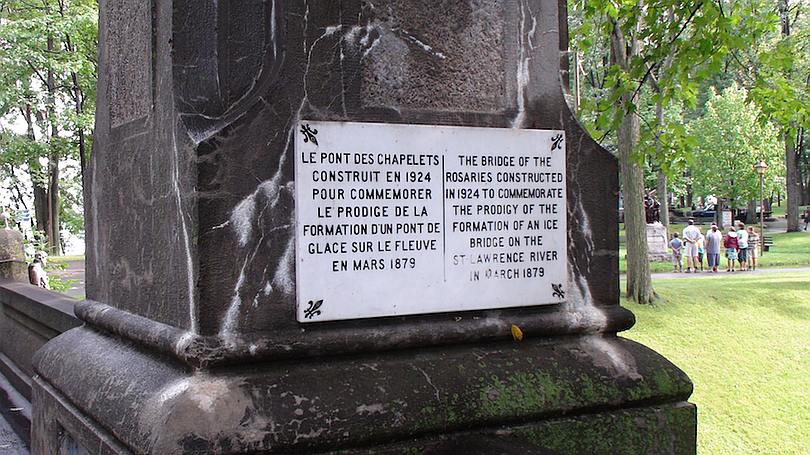
March 14th he went over in his boat to examine the hay. When he came back to Cap-de-la-Madeleine, he advised Fr. Duguay that there was no sign of ice anywhere, and that the priests should give up the idea of a bridge of ice at least for this year. Why not use our boats? he asked. Fathers Desilets and Duguay both told him that the parish could not afford such a venture and, secondly, they pointed out that some of the stones weighed 3,000 pounds and the small boats that they had could not handle such weights. Then, quietly, Fr. Desilets said that there would be a bridge of ice within the week and that he considered the matter closed. The parishioner left the priests thinking to himself that the men of God could, at times, be very simple and very foolish. He would, however, get his hay across in the boat and leave the priests to their foolish ideas. He and a companion did get across with the first load of hay to Cap-de-la-Madeleine, but that was all; because a great wind arose and they were unable to cross the river again at this point. This incident is very important, because it serves to point out that the river was free of ice at this date, and that it was open to navigation on March 14th, 1879. Saturday was very heavy and overcast, and Fr. Duguay later reported that the winds stripped the mouth of the St. Maurice river on that Saturday. By this he meant that the ice-floes which had jammed the mouth of the river were freed and able to follow the river's flow. Sunday morning, the people arose to a quieter day, but on looking at the river they saw that the St. Lawrence was covered with ice floes and sheet ice. They were by no means impressed because they figured that this was the last of the ice flowing down the river, and was it not also a sign of the coming spring? However, the good priests were impressed and Fr. Duguay said the public Rosary as usual and announced that when the prayers were all finished, he would lead the way across the river on the ice. It is recorded that the people were skeptical of this being possible, and some of them even thought that the poor priest was losing his sanity. At the same time Fr. Duguay also announced that the High Mass in honor of St. Joseph would be offered, as promised, on his Feast Day which was the following Wednesday. This was how sure the priests felt that the ice was in answer to the prayers of the people.
Crazy or not, Fr. Duguay and some of the more courageous men set out to cross the ice and they found that in parts the ice would bear their weight, but that in other parts it was too thin. They found that they were unable to go across the river in a straight line, but had to feel their way with a rod and oftentimes had to proceed on their hands and knees for fear that the ice would give way under them. Thus they reached the far shore and found that they had crossed the river in the manner of an inverted vee. The men and the priest returned again to the church side of the river, and word was sent to all the men of the parish to come and help with the work. There was a great deal of work to be done, for the ice-floes had to be cemented together, as it were, with water and slush ice. Layer after layer of water was poured on the floes, just like on an ice skating rink, until there was a solid bridge from side to side. What had seemed impossible before was now a veritable fact and THE BRIDGE OF ICE WAS NOW A REALITY. There was a lot of work to be done – work that was dangerous and nerve-wracking. To prove how small and narrow the bridge was, it is recorded that in the center there was not enough room for two horses and sleds to pass each other. It required nerve and courage to cross again and again, but the men and the horses never faltered even once.
Fr. Desilets was confined to his bedroom owing to his ill-health, but he organized the women and children into groups. While the men and horses were at work, the women and children kept up a continual barrage of Rosaries that matched the labors of the men. An interesting sidelight to this is the story told of the mothers who kept the children walking around the kitchen table to keep them awake. As the men toiled away in the dark of the night, they could look back to the shore and see the light in Fr. Desilet's room window and know that the priest and the women and children were praying for them. Thus it was that they themselves called the Bridge of Ice the Bridge of the Rosaries. There is no doubt that the people of the Cape looked upon the Bridge of Ice as a miracle sent from Heaven by Our Lady.
On Tuesday, March 18th, 1879, the first load of stones arrived at the Cape and from then on until March 25th the men and the horses worked night and day, never ceasing in their efforts to get the stones across. On the 25th of March, the Feast of the Annunciation, it was decided that there was enough stone across to build up to the level of the windows, and that would do for the time being. Also, the Bridge of Ice was beginning to melt away, and on the 26th of March it began to break up and flow down the river as it had been doing before Our Lady intervened.
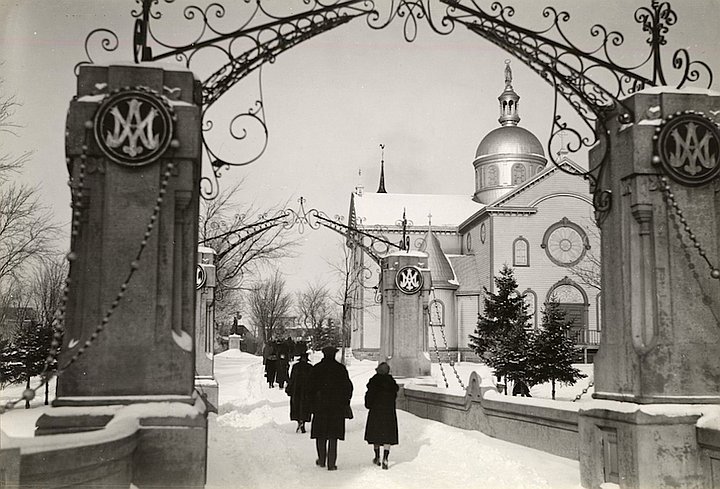
Naturally, word of this occurrence spread far and wide and the crowds of people who came from Three Rivers and the neighboring towns were immense. It would seem that the Queen of the Rosary wanted people to come to Cap-de-la-Madeleine and She used Her own ways to accomplish this. First there was the Bridge of Ice. Next, there was the natural curiosity of the people who having read the accounts of this in the newspapers came to see the place where this had happened. Having come, they were impressed by the saintly Fr. Desilets, especially when they heard him preach on Our Lady and Her Rosary.
There came to the Cape at this time a man who was to leave his mark and influence on the whole place. This man was Fr. Frederic Jansoone de Ghyvelde, a Franciscan Friar, who was newly arrived from the Holy Land. This holy priest was very humble and his advice and help were greatly appreciated by Fathers Desilets and Duguay. The meeting between Fr. Desilets and Fr. Frederic was the meeting of two men whose lives and ministry were devoted to God and His Wonderful Mother. Fr. Frederic was a great preacher and people flocked to the church to hear his sermons and to see his obvious piety and devotion which was always evident. It would seem that again Our Lady had chosen another link in the chain of events that was leading to the fulfillment of Her wishes. Fathers Desilets and Duguay, though both were learned and pious men, were far from experienced in the handling of crowds and the organization of pilgrimages which now were growing larger every day. On the other hand, Fr. Frederic had great experience in this field and we may be sure that his advice on these matters was greatly appreciated by the two priests.
In 1883, the Bishop of Three Rivers gave his full encouragement to the Shrine and arranged that a pilgrimage should go to the Cape. These groups had been growing larger and larger each year and now these would be larger still since the Bishop had given his support. (Later, in 1892, an indulgence from Rome was granted by Pope Leo XIII.) It would seem that the time was now ripe for Fr. Desilets to have the day of dedication of the Shrine in fulfillment of his vow. Already the large groups coming to the Cape had signaled this, but with the official encouragement being received, he could no longer postpone the day. Also reports of cures and favors received were beginning to pour in. Now all was ready and Fr. Desilets decided that the Shrine would be formally dedicated in June, 1888. The Church of Saint Mary Magdalen had been finished and dedicated and now the old stone church had been scrubbed clean, repainted and repaired as needed. Fr. Desilets wanted to have just a formal ceremony with no outward show but, even so, the people from all round the district flocked there that morning. Now the small church was filled to overflowing, yet in this same church but twenty-one years previously, Fr. Desilets stood forlorn, alone, neglected and unwanted by these same parishioners. The wheel had turned full cycle and Our Lady had changed the lukewarm into ardent and fervent followers of Her Rosary.
June 22, 1888 Fr. Desilets sang the High Mass and Fr. Frederic preached the sermon. If Fr. Desilets was reticent and slow
to move, Fr. Frederic was the opposite. Publicly, Fr. Frederic made a prophecy and a request. His prophecy is notable in its exactness
and worthy of repeating in its entirety: In years to come, this will be the Shrine of Mary; pilgrims will come from all the families of
this parish, from all the parishes of this Diocese and from all the Dioceses of Canada. Yes, this little house of God will be too small
to contain the crowds that will come to invoke the power and the bounty of the sweet Virgin of the Most Holy Rosary.
Above all,
Fr. Desilets wanted some sign that he was following Our Lady's wishes in dedicating the church under the title of Our Lady of the
Most Holy Rosary. As he preached, Fr. Frederic publicly asked Our Lady to give a sign that this was what She wanted, perhaps by
curing some of the invalids who were present. But no cripple walked; no blind person was restored to sight. In fact, just nothing.
The three priests spent the day among the people who had come for the ceremony. Towards evening, after the priests had
eaten their dinner, a cripple came to the rectory and asked to be brought into the new Shrine of Our Lady. Fathers Desilets and
Frederic brought the cripple, Pierre Lacroix, to the church and put him sitting on a chair in front of the High Altar and beneath
the statue of Our Lady. The priests knelt at the Altar rails one on each side of Pierre, but not blocking his view. They all prayed
silently for a while and THEN IT HAPPENED. The cripple looked up at the statue and then he saw that the eyes of the statue were opened
in a lifelike manner and the color of life was coursing over its face. Fathers Desilets and Frederic had seen the same thing happening
and now Fr. Desilets could restrain himself no longer. He rose and went over to Fr. Frederic and said to him: Do you see what I see;
do you see it?
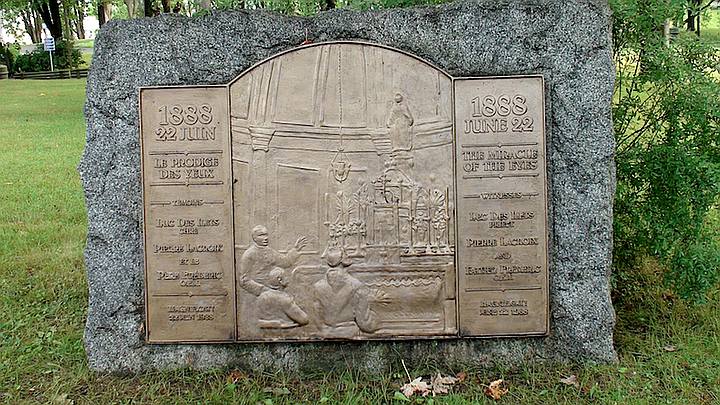
Yes,
said Fr. Frederic, the statue has opened its eyes, hasn't it?
Pierre made known that he had seen the
very same thing but the two priests were still not satisfied. They moved around before the Altar to make certain that they were not
being subject to a hallucination and that they were not just imagining the whole thing. They went to various parts of the church,
but the phenomenon was still obvious. No matter where they moved they could still see the statue with the eyes open, looking lovingly,
yet sternly but full of majesty; looking as it were, at the future years and the crowds who were to come in pilgrimage to this very spot
and kneel and pray at the feet of this very statue.
Here was the sign that the priests had looked for earlier in the day. Here it was when all was quiet and the crowds had gone home. How often it happens that there is no public miracle, no public demonstration. As had happened so often before, Our Lady had made Herself known to but just a few. At a large number of Her apparitions, children were the only ones privileged to see Her and talk with Her. At others, it was to a saintly nun in the cloister or an ascetic priest with whom She conversed; but here at the Cape, She made exceptions that were remarkable. Firstly, there was no verbal message, no admonitions to prayer and penance. Next, She did not make a full appearance, but used the inanimate statue to signify Her pleasure that this Shrine had been dedicated to Her under the title of the Queen of the Most Holy Rosary. Then, there was a cripple present with the two priests; one of the priests was to die soon, the other was to work on for years giving glory to Our Lady; and the cripple – he must surely have been chosen to show that here to this spot would come those whose vocation is so dear to the heart of God and His Mother – the sick and the crippled and the handicapped.
The Prodigy of the Eyes took place quietly and with no fanfare. The three witnesses were unimpeachable in their testimony and the passage of time has proved this. Fr. Desilets died on August 20th, 1888 and we can have no better assurance of the Prodigy being a true fact than that he attested to the happening even to his deathbed, and surely a holy priest would not tell of something untrue when he knew that in a few moments he was going to meet his Maker. Fr. Frederic took every opportunity in the remaining years of his life to refer to this Prodigy and he wrote about it in minute detail. Like all others to whom Our Lady had appeared, Fr. Frederic could never tire of describing the wondrous beauty of the living face of the Statue. Pierre Lacroix, though crippled, took every opportunity to go back over those few exquisite minutes and his foretaste of Heaven. On his deathbed, Pierre signed an affidavit that he had witnessed the Prodigy and that his statements were true regarding this happening.
So Fr. Desilets died and Fr. Duguay now was pastor at the Cape. He had a long and arduous task before him, because the pilgrimages were now starting to come in larger and larger numbers and more frequently than before. However, Fr. Frederic was always near at hand to assist where needed and to guide with the hand of experience the growth of the Shrine. Reports were coming in from all sides of supposed cures and these reports grew in number year by year. The Annals magazine was published for the first time in 1892 and from then on, each issue contained letters, stories and reports of these cures. These reports carry the testimony of the doctors and others concerned in the case, but no observation is made. The extent to which the supernatural entered into these matters is known to God alone and only Mother Church has the right to pronounce upon these events.
Each year, the number of pilgrimages and pilgrims grew in leaps and bounds, so the basis was laid for the present Shrine. Ground was acquired by the priests and Fr. Frederic planned and marked out the Stations of the Cross (image below). Simple crosses marked the site of each station and the Via Dolorosa followed closely the original in Jerusalem. But the immensity of the work of running a shrine like this overwhelmed Fathers Duguay and Frederic, so it was decided to get a Religious Order to take over the care of the Shrine.
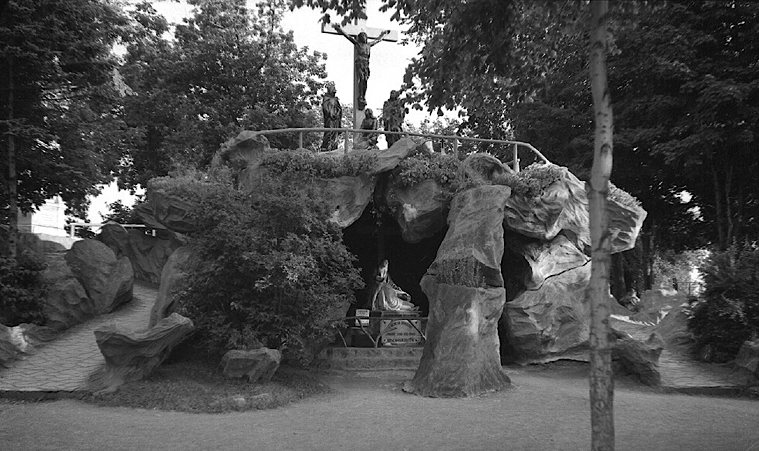
Thus, in 1902, the Oblates of Mary Immaculate came to Cap-de-la-Madeleine, and so began the present era of the Shrine. These priests were dedicated to the caring for Shrines of Our Lady all over the world and it was only natural that they should come to take care of one of the greatest shrines in the Americas. Under the care of the Oblate Fathers, the Shrine grew in size and the grounds were added to as the need arose. This work added to the beauty of the place and helped to make the Shrine so famous for its landscaping.
The year 1904 was to be a memorable one for Cap-de-la-Madeleine. This was a year of great celebrations in honor of Mary throughout the whole world, it being the 50th anniversary of the Dogma of the Immaculate Conception. A request was made to have the Statue of Our Lady crowned and in a short time word was received back from Pope Saint Pius X that this permission was granted. The privilege of being crowned solemnly in the name of the Holy Father is a rare one, granted only to statues at the most honored and most frequented places of pilgrimages. It was granted to Our Lady of Guadalupe, Mexico's national Madonna, in 1895 and no other statue in Canada has received this privilege. The date was set – October 12, 1904, and the arrangements were all completed. The Apostolic Delegate was there; sixteen Archbishops and Bishops were present and countless clergy and laity. After the High Mass came the actual ceremony. The Bishop in his splendid robes moved over towards the statue. Behind him, carrying the golden crown on a silken cushion, came Fr. Frederic in his humble Franciscan habit. The crown was blessed and placed on Our Lady's head and then all present were filled with excitement and emotion. Joy filled the hearts of all, but there were a few who shared in a special joy on this special day. Fathers Duguay and Frederic must have had great feelings of joy and happiness to see the culmination of their work and to know that from that moment on, this was to be the National Shrine of Canada, and that the crown was to be the sign of Our Lady's power and royalty. The Irish of Montreal must have had great feelings of pride and joy to know that it was they who donated the crown that now rested on Our Lady's head, thereby uniting their love for Mary to that of their forefathers who had suffered so much for Her and Her Son. But above all, each Canadian Catholic must have felt a personal pride that Cap-de-la-Madeleine was now the National Shrine of Mary in Canada and that all Canada could kneel at Our Lady's feet.
After this the Oblate Fathers and Lay Brothers vied with each other in their zeal to make the Shrine more beautiful.
From 1906 to 1908, the priests and brothers planted 780 trees – which continue to give pilgrims shade and shelter. During the period
of 1906 to 1910, the unique Way of the Rosary with its fifteen bronze representations made by skilled French craftsmen, were erected.
In 1914, the Rosary spring was redirected to its present site with its own little grotto. From 1913 to 1916, the old wooden crosses
of the Via Dolorosa were replaced by the present Stations, which still maintain their exact relation to the original Via Dolorosa in
Jerusalem. Fr. Frederic, from his vast storehouse of knowledge, organized the Way of the Cross and he kept it as close to the original
as humanly possible. In fact the Tomb or, as we call it, the Fourteenth Station, is an exact replica of the Tomb at Jerusalem
(image above). Then in 1924, the Bridge of the Rosaries was erected and blessed. Next came the Pilgrim's House in 1937 and
St. Mary's Lake was added in 1938 (image below). Various other additions have been made since then and the most noticeable of
these is the modern guest house known as Madonna House.
Here the Guardian Fathers took every care to look after the needs of
the pilgrims and especially the crippled.
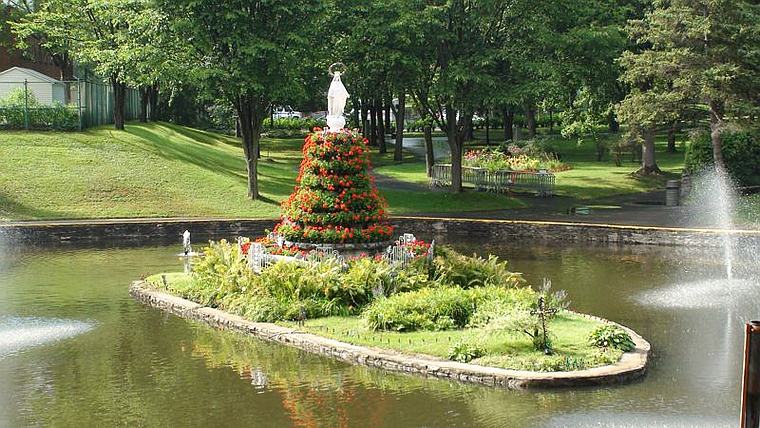
After World War II, the Shrine seemed to have received new vigor. In 1953, the Perpetual Rosary Crusade was founded and since then, the Rosary was said night and day, in shifts, for the spiritual defense of Canada and for peace throughout the whole world. These people come from all over the province of Quebec and in three shifts a day so that there will always be someone in the Shrine praying the Rosary. For each group that came, there was Mass and Holy Communion and, on important Feast Days, a sermon or homily on the Feast.
It would seem that Our Lady's statue has an urge for traveling. Twice She has made journeys that are remarkable. The first one was in 1947 for the Ottawa Marian Congress; another the same year, a 6,3OO-mile train journey to the west coast of the United States with Archbishop Beckman's Confraternity of Pilgrims; then more in conjunction with the Marian Year of 1954, when She journeyed all around Canada and then came back to the Cape again. This Pilgrim Virgin is a replica of the Statue over the High Altar and was received with warm welcome everywhere She went.
Then came the wonderful celebrations at Three Rivers of the National Marian Congress of August 5 to 15, 1954 to mark the
Centenary of the Dogma of the Immaculate Conception and of the Miraculous Statue
given originally to mark that Definition.
Miraculous Statue itself was taken down from over the High Altar in the Shrine and brought in procession to Three Rivers.
Here the Papal Legate and the Cardinals and Clergy were waiting. On the arrival of the statue, the ceremonies began and the
culmination was the second crowning of Our Lady's statue by the Delegate of Pope Pius XII. How the people cheered and what joy
they all felt, especially when their beloved Mother was received in such honor. Back again to the Shrine came the Miraculous Statue,
and the people of Cap-de-la-Madeleine breathed a sigh of relief, that their Statue was back in place safely.
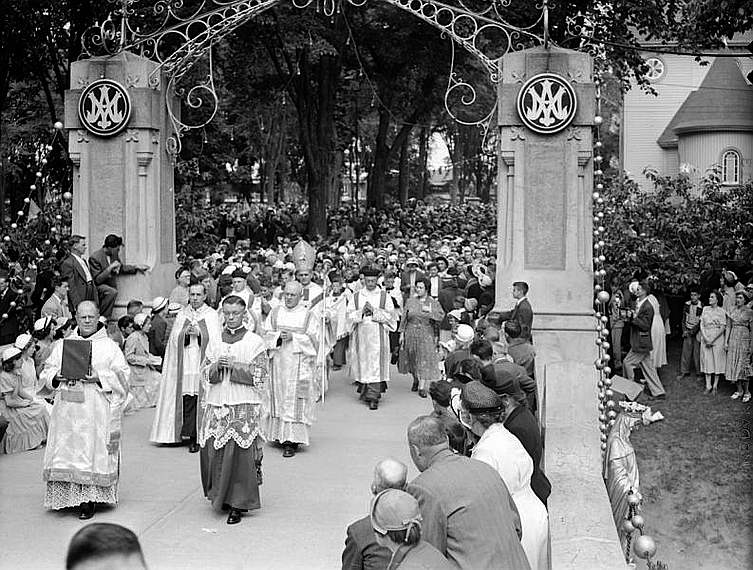
Contact us: smr@salvemariaregina.info
Visit also: www.marienfried.com